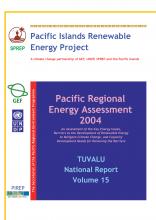(PIREP) Pacific Regional Energy Assessment 2004 : an assessment of the key energy issues, barriers to the development of renewable to mitigate climate change, and capacity development needs to removing the barriers : Tuvalu National Report / Herbert Wade

Climate Change Resilience
Available Online
As is the norm for atolls, the soil is low in fertility and only a narrow range of food plants can be supported. The sea is the primary source of local food. The climate is tropical to equatorial. Tuvalu has had tropical cyclones to cause serious damage but their passage is not common though storm surges, winds and heavy rain can be damaging to the low lying islands even if a cyclone does not actually go through Tuvalu. Rainfall averages 3500 mm per year with April - November lower than the rest of the year. Droughts do occur and maintaining a fresh water supply on densely populated Funafuti is increasingly a problem. The primary source is rainwater but in recent years a 65,000 1/d desalinator is also in use. Some pumping from wells is possible but water is brackish and wells can easily be over pumped and cause an incursion of salt water.
